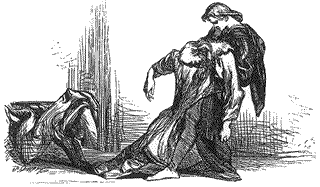![]()
Hamlet's Response to Corruption
| 'Tis now the very witching time of night, When churchyards yawn, and hell itself breathes out Contagion to this world. Now could I drink hot blood, And do such bitter business as the day Would quake to look on. (III.ii.367-371) |
According to H.D.F. Kitto, while Hamlet demonstrates to himself, through the play scene, that killing Claudius is an act of justice, it is nonetheless evil. Thus, Hamlet delivers himself into the rank contagion that surrounds him in resolving to do so. A sequence of evil actions is initiated even before the play begins with poison and it concludes with poison. Hamlet not only yields himself to that vile flood, but becomes an active agent in it.

Kitto's vision of Hamlet is founded on the Greek notion from Aeschylus
of the crime that sets a flood of crimes in motion
| The conception which unites these eight persons [the eight who are eventually killed] in one coherent catastrophe may be said to be this: evil, once started on its course, will so work as to attack and overthrow impartially the good and the bad; and if the dramatist makes us feel, as he does, that Providence is ordinant in all this, that, as with the Greeks, is his way of universalizing the particular event. - H.D.F. Kitto, Form and Meaning in Drama, Barnes and Noble, New York, 1956. p.350. |
Religious interpretations of Hamlet cling to unflagging moral absolutes which are represented by notions of good and evil. When such a ruler is applied to the events of Hamlet, the central character comes up short. He is is at first, drawn into a course of evil, and eventually ends up wallowing in it and ultimately contributing to the evil in the world of the drama. This does not, however, necessarily make Hamlet less engaging or less worthy of our emphatic involvement with his plight. Classical tragedy has repeatedly pondered the question of how a "good" person could perform horrible acts. As Aristotle describes it, the culprit for the ancients was error. In Shakespeare's drama it is frequently either the beguiling personality of evil (Iago) or, as in the case of Hamlet, it's compelling force. What is most interesting, however, is that there is a point of revelation which brings us to the confirmation of the essential goodness of the central character, despite the horrible deeds they have committed.